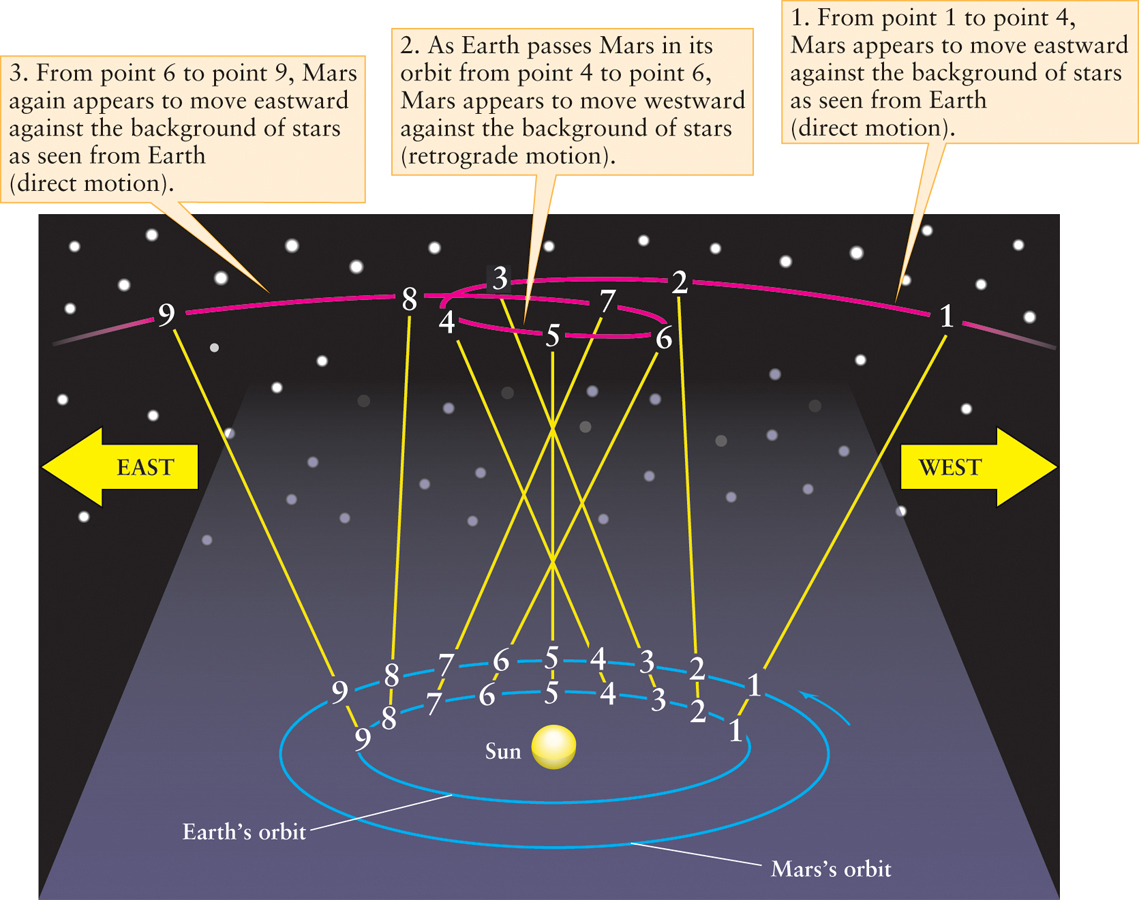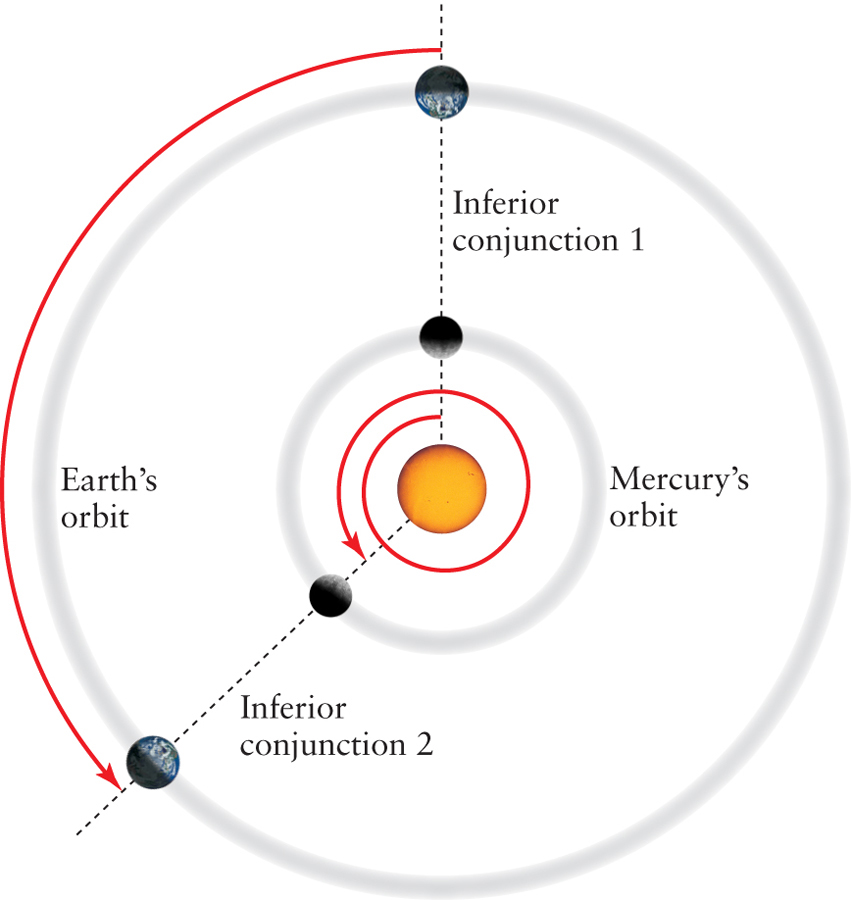3-2 Nicolaus Copernicus devised the first comprehensive Sun-centered model
The idea that the most simple and most straightforward explanation of observations in nature is most likely to be correct is called Occam’s razor, after William of Occam (or Ockham), the fourteenth-century English philosopher who first expressed it. (The “razor” refers to shaving extraneous details from an argument or explanation.) Although Occam’s razor has no proof or verification, it appeals to a scientist’s sense of beauty and elegance, and it has helped lead to the simple and powerful laws of nature that scientists use today. Clearly, Ptolemy’s incredibly complicated mechanism for predicting the motions of planets is inconsistent with Occam’s razor. The first astronomer to suggest a simpler and more straightforward model was the Greek astronomer Aristarchus, who in the third century b.c. suggested a Sun-centered, or heliocentric, model as a way to explain retrograde motion, but it was not widely accepted.
A Heliocentric Model Explains Retrograde Motion
 Go to Video 3-2
Go to Video 3-2
Imagine riding on a fast racehorse. As you pass a slowly walking pedestrian, he appears to move backward, even though he is traveling in the same direction as you and your horse. This sort of simple observation inspired Aristarchus and others to formulate a heliocentric (Sun-centered) model in which all the planets, including Earth, revolve about the Sun. In this way of thinking, planets take different lengths of time to complete an orbit, so from time to time one planet will overtake another, just as a fast-moving horse overtakes a person on foot. When Earth overtakes Mars, for example, Mars appears to move backward in retrograde motion, as Figure 3-6 shows. Thus, in the heliocentric picture, the occasional retrograde motion of a planet across the sky is an illusion due to Earth’s motion.

Imagining a system where a spinning Earth orbits the Sun more easily describes observed retrograde motion.
In the last section, we described how Aristarchus demonstrated that the Sun is bigger than Earth. If the Sun is enormous in size compared to Earth, it becomes a bit more sensible to imagine a small Earth orbiting a larger Sun. He also imagined that Earth rotated on its axis once a day, which explained the daily rising and setting of the Sun, Moon, and planets and the diurnal motions of the stars. To explain why the apparent motions of the planets never take them far from the same path through the sky, Aristarchus proposed that the orbits of Earth and all the planets must lie in nearly the same plane.
70
This Sun-centered model is conceptually much simpler than an Earth-centered system, such as that of Ptolemy, with all its “circles upon circles.” In Aristarchus’s day, however, the idea of an orbiting, rotating Earth was not widely accepted given Earth’s apparent stillness and immobility.
Question
ConceptCheck 3-5: In the heliocentric model, would an imaginary observer on the Sun look out and see planets moving in retrograde motion?
Copernicus and the Arrangement of the Planets
How can an observer determine which planets are closest to the Sun and which are farthest away? If you have a telescope, you can sometimes tell that some appear larger than others. But what if you do not have a telescope and planets appear to be shiny dots in the sky? For early astronomers, the order of the planets from closest to the Sun to most distant from the Sun was largely guesswork. During the first half of the sixteenth century, a Polish lawyer, physician, canon of the church, and gifted mathematician named Nicolaus Copernicus began to construct a new model of the universe. His model, which placed the Sun at the center, explained the motions of the planets in a more natural way than the Ptolemaic system, consistent with Occam’s razor.
Copernicus came to realize that you could use the heliocentric model to determine the arrangement of the planets without ambiguity. Copernicus realized that because Mercury and Venus are always observed fairly near the Sun in the sky, their orbits must be smaller than Earth’s. The other visible planets known at that time—Mars, Jupiter, and Saturn—are sometimes seen on the side of the celestial sphere opposite the Sun, so these planets appear high above the horizon at midnight (when the Sun is far below the horizon). When this happens, Earth must lie between the Sun and these planets. Copernicus therefore concluded that the orbits of Mars, Jupiter, and Saturn must be larger than Earth’s orbit.
The heliocentric model also explains why planets appear in different parts of the sky on different dates. Both Mercury and Venus go through cycles as they orbit the Sun: They are seen in the west after sunset for several weeks or months, then for several weeks or months in the east before sunrise, and then in the west after sunset again.
Figure 3-7 shows the reason for this cycle. When Mercury or Venus is visible after sunset, it is near greatest eastern elongation. (The angle between the Sun and a planet as viewed from Earth is called the planet’s elongation.) The planet’s position in the sky is as far east of the Sun as possible, so it appears above the western horizon after sunset (that is, to the east of the Sun) and is often called an “evening star.” At greatest western elongation, Mercury or Venus is as far west of the Sun as it can possibly be. It then rises before the Sun, gracing the predawn sky as a “morning star” in the east. When Mercury or Venus is at inferior conjunction, it is between us and the Sun, and it is moving from the evening sky into the morning sky. At superior conjunction, when the planet is on the opposite side of the Sun, it is moving back into the evening sky.

A planet farther from the Sun than Earth whose orbit is larger than Earth’s, such as Mars, is best seen in the night sky when it is at opposition. At this point the planet is in the part of the sky opposite the Sun and is highest in the sky at midnight. This is also when the planet appears brightest, because it is closest to us. Alternatively, when a planet is located behind the Sun at superior conjunction, it is above the horizon during the daytime and thus is not well placed for nighttime viewing.
Question
ConceptCheck 3-6: If Venus is visible high in the evening sky after sunset, is it leading Earth in its orbit or behind Earth?
Question
ConceptCheck 3-7: How many times is Mars at inferior conjunction during one orbit around the Sun?
71
Planetary Periods and Orbit Sizes
The Ptolemaic system has no simple rules relating the motion of one planet to another. But Copernicus showed that there are such rules in a heliocentric model. In particular, he found a correspondence between the time a planet takes to complete one orbit—that is, its period—and the size of the orbit.
Determining the period of a planet takes some care, because Earth, from which we must make the observations, is also moving. Realizing this, Copernicus was careful to distinguish between two different periods of each planet. The synodic period is the time that elapses between two successive identical configurations as seen from Earth—from one opposition to the next, for example, or from one conjunction to the next (Figure 3-8). The sidereal period is the true orbital period of a planet, the time it takes the planet to complete one full orbit of the Sun relative to the very distant background stars.

There is a definite relationship between the sidereal period of a planet and the size of its orbit, as listed in Table 3-1. One can see that the farther a planet is from the Sun, the longer it takes to travel around its orbit (that is, the longer its sidereal period). Today, we understand this is so for two reasons: (1) The larger the orbit, the farther a planet must travel to complete an orbit; and (2) the larger the orbit, the slower a planet moves. For example, Mercury, with its small orbit, moves at an average speed of 107,000 mi/h (47.9 km/s). Saturn travels around its large orbit much more slowly, at an average speed of 9.64 km/s (21,600 mi/h).
| Synodic and Sidereal Periods of the Planets | Average Distances of the Planets from the Sun | |||
|---|---|---|---|---|
| Planet | Synodic period | Sidereal period | Copernican value (AU*) | Modern value (AU) |
| Mercury | 116 days | 88 days | 0.38 | 0.39 |
| Venus | 584 days | 225 days | 0.72 | 0.72 |
| Earth | 1.0 year | 1 | 1 | |
| Mars | 780 days | 1.9 years | 1.52 | 1.52 |
| Jupiter | 399 days | 11.9 years | 5.22 | 5.2 |
| Saturn | 378 days | 29.5 years | 9.07 | 9.55 |
| Uranus | 370 days | 84.1 years | 19.19 | |
| Neptune | 368 days | 164.9 years | 30.07 | |
| *1 AU = 1 astronomical unit = average distance from Earth to the Sun | ||||
Question
ConceptCheck 3-8: What causes the planets to stop and change their direction of motion through the sky in the heliocentric model?
Question
ConceptCheck 3-9: Why is Jupiter’s sidereal period longer than its synodic period?
The Shapes of Orbits in the Copernican Model
One might think that Copernicus’s heliocentric model was more accurate than Ptolemy’s geocentric model. Copernicus found that when he used perfectly circular orbits for a planet’s path around the Sun, he could not accurately describe the paths of the other planets. As a result, he had to add extra tiny orbits to each planet’s orbit, much like Ptolemy used. However, it needs to be emphasized that he added extra motions to improve the accuracy of his model, not to explain retrograde motion. Rather, these tiny orbits on orbits helped Copernicus account for slight variations in each planet’s speed along its orbit.
72
Copernicus compiled his ideas and calculations into a book entitled De revolutionibus orbium coelestium (On the Revolutions of the Celestial Spheres), which was published in 1543, the year of his death. For several decades after Copernicus, most astronomers saw little reason to change their allegiance from the older geocentric model of Ptolemy. The predictions that the Copernican model makes for the apparent positions of the planets are, on average, no better or worse than those of the Ptolemaic model. The test of Occam’s razor does not really favor either model, because both use a combination of circles to describe each planet’s motion.
More concrete evidence was needed to convince scholars to abandon the old, comfortable idea of a stationary Earth at the center of the universe.
Question
ConceptCheck 3-10: Why was Copernicus’s model more accurate than Ptolemy’s model?